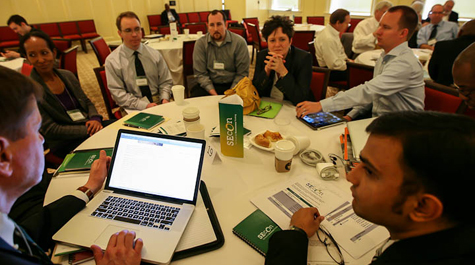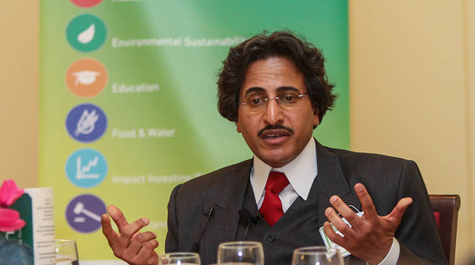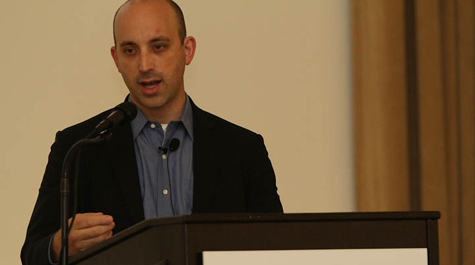Social Entrepreneurs-in-training want to make a difference – and a living
The Millennials, students born between 1980 and 1996, are gathered at William & Mary’s Mason School of Business for the first annual social entrepreneurship conference. They are tackling some of the world’s most vexing problems. Malaria in Africa. Water shortages in dry land countries.
At the food and water roundtable, they’re brainstorming innovations to secure food for a growing world population. By 2050, 9 billion people will need to be fed, according to the latest United Nations projections. That’s a 32-percent world population increase from 6.8 million today, coupled with the daunting USDA statistic that already 1 in 7 individuals doesn’t have enough food to eat.
“We will need to produce as much food in the next 40 years as we have in the last 8,000,” said Jody Carmen, director of executive services for the U.S. Meat Export Federation. Her organization promotes the distribution of beef, pork, veal and lamb to international markets such as China, Europe and the Middle East.
“The problem is that we don’t have the land, so where is this food going to come from?” She questions the audience as students furiously take notes on their laptops and iPads.
{{youtube:medium|amTiBVMQ8Mo}}
Approximately 100 business leaders and 50 students spent a day and a half discussing this newly emerging cross-disciplinary academic field at the SEcon 2012 Forum, investigating topics such as health, environmental sustainability and education.
In a sea of black and navy blue suits, Millennial Vibha Chokhani ’12 sits at one of the roundtables surrounded by business leaders from the for-profit and non-profit world. She’ll be graduating this spring from the MBA program and came to William & Mary intending to gain the tools needed to be a social entrepreneur.
“We’re not getting any more land to cultivate the food and provide for all these people that we need to feed, so there’s room for more innovation, for thinking differently in terms of how we engage in public-private partnerships to develop and think of ways to feed the world,” said Chokhani.
Looking toward the future, she feels trade agreements between governments will be crucial for food security. “But where business – and social entrepreneurship – plays a role is if largely populated countries, such as India and Pakistan, can innovatively feed their own population,” said Chokhani. “Then, those countries such as Pakistan, which is known for large agricultural business, can look at exporting to some countries that don’t have the natural resources to produce their own food.”
Currently, 80 colleges and universities have either a center, masters, or minor in social entrepreneurship, according to Ashoka, the leading global organization for social entrepreneurs. More than 600 professors worldwide are teaching courses on this subject, reports Ashoka, which in 2005 co-founded a university component called Ashoka U. It’s the first comprehensive and global association of faculty and institutions working to advance the academic field of social entrepreneurship.
{{youtube:medium:left|MRYEjk8VTeo}}
For the first time this semester, William & Mary is offering an undergraduate course on social entrepreneurship. More than 75 students applied for 24 slots, said Associate Professor Scott McCoy. McCoy is teaching young people the value of social innovation and how business principles can be fused with creative solutions to address social needs.
“Historically, William & Mary is always in the Top 10 mid-sized universities for sending students to the Peace Corps,” said McCoy, a former volunteer himself. “Now our students have the skills through the Business School and other courses to make that connection and make a social change.”
Director of Community Engagement Drew Stelljes is teaching a course on the Achievement Gap and focusing on how social entrepreneurial tools can be used in the education field. Ten students are working to develop programs to combat school readiness and opportunity gaps for children of various subgroups. Students from both McCoy’s and Stelljes’ class are prepping for a “poster” session where they will be given the opportunity to pitch practical business ideas to conference attendees. See story by Erin Zagursky.
For many, conceptualizing social entrepreneurship can be difficult, especially when the term is a bit ambiguous. At the core, social entrepreneurs are innovators who take a business-like approach to solving social problems. They can be companies or individuals, like George Srour ’05, who founded Building Tomorrow on just $30 while living in his parents’ basement. Since 2006, Srour’s company has built 15 schools in Uganda, and recently entered into a partnership with the Clinton Global Foundation to build 60 schools in the next five years.
Non-profits have been more commonly known for having a positive social or environmental impact on the local community. And in the past, major revenue generating corporations have primarily been focused on their social responsibility – or making sure they do no harm. Scholars use the term “corporate social responsibility” to define their role.
{{youtube:medium:left|_FngCGmEWsE}}
But now, there’s a cross pollination between for-profits and non-profits when it comes to social entrepreneurship, said Chris Adkins, executive director for William & Mary’s Undergraduate Business Program. Businesses are using the lens of social entrepreneurship to innovate where the outcomes are financially, socially and environmentally beneficial.
“It’s not just to think about how to avoid a negative impact from a social and environmental aspect,” said Adkins, “but how to incorporate social and environmental good into one’s core strategy as a business.”
Adkins cites several companies who have taken the “first mover advantage,” a strategy companies use to say ‘we’ll be better at this than our competitors.’ IBM’s smarter planet campaign leverages their expertise in data analytics and consulting services to address a range of social and environmental problems facing cities, from pollution, to security and education, he said. Shipping giant Maersk is investing in innovative ships that optimize fuel efficiency, cargo space, and travel speeds, creating shared economic and environmental value.
Adkins, who teaches a business ethics course and routinely works with large corporations such as IBM, said three main factors are driving social entrepreneurship: increased awareness of declining resources, an interconnected world and the unique genetic makeup of the Millennial generation.
“Within the next three years, Millennials will be 50 percent of the workforce,” said Adkins. Aside from being techy-savvy and mindful about the global problems facing society, Adkins says it’s the staggering large size of the Millennials that makes them a force to be reckoned with.
“And what those numbers mean for a company is that they have to look at them very seriously as a consumer, as client, as a potential employee,” he said. “At William & Mary, we have the opportunity to be a game changer in business education as we explore these new models of social entrepreneurship and sustainability with our students, faculty and business leaders.”
Take Chokhani, for example, who will be attending a social entrepreneurship case competition at Brigham Young University later this March. She says businesses not only have a duty, but are the most capable to tackle these social challenges head on.
“I expect – without batting an eyelid – that my future company is doing more than it should to not just throw some money toward a cause after they’ve done harm or just doing philanthropy,” she said. “But to really incorporate social focus in their business model.”
 Skip to main content
Skip to main content



